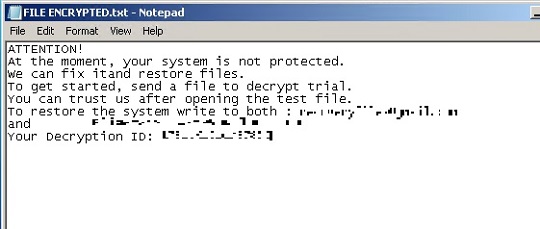Ransom.Win32.BTCAZADI.THIAHBC
Ransom:Win32/CylanCrypt.PAC!MTB (MICROSOFT), Trojan-Ransom.FileCrypter (IKARUS)
Windows


Threat Type: Ransomware
Destructiveness: No
Encrypted: No
In the wild: Yes
OVERVIEW
This Ransomware arrives on a system as a file dropped by other malware or as a file downloaded unknowingly by users when visiting malicious sites.
It drops files as ransom note.
TECHNICAL DETAILS
Arrival Details
This Ransomware arrives on a system as a file dropped by other malware or as a file downloaded unknowingly by users when visiting malicious sites.
Installation
This Ransomware drops the following files:
- {Malware Directory}\RUN.dll
It adds the following processes:
- cmd.exe /c vssadmin.exe delete shadows /all /quiet
It adds the following mutexes to ensure that only one of its copies runs at any one time:
- Global\elibeMutex
Other Details
This Ransomware does the following:
- Sets the current process priority to highest
- Empties the recycle bin
- Uses the system's max thread count upon execution
- Encrypts removable, fixed, remote drives
It accepts the following parameters:
- -path : Specify the path to encrypt
- -ratio : Encryption ratio
- -nomutex : Don't use mutex
- -nonetdrive : Ignore encryption in network drives
- -selfdel : Self-delete after execution
Ransomware Routine
This Ransomware avoids encrypting files with the following strings in their file name:
- ntldr
- ntuser.dat
- bootsect.bak
- ntuser.dat.log
- autorun.inf
- thumbs.db
- iconcache.db
- bootfont.bin
- boot.ini
- desktop.ini
- ntuser.ini
- bootmgr
It avoids encrypting files found in the following folders:
- Windows
- $Windows.~bt
- $windows.~ws
- windows.old
- windows nt
- Public
- Intel
- PerfLogs
- System Volume Information
- MSOCache
- Default
- Config.Msi
It appends the following extension to the file name of the encrypted files:
- {Original File Name}.{Original Extension}.EMAIL=recoveryfile7@gmail.com.ID={Generated ID}.elibe
It drops the following file(s) as ransom note:
- {Encrpyted Directory}\FILE ENCRYPTED.txt

SOLUTION
Step 1
Trend Micro Predictive Machine Learning detects and blocks malware at the first sign of its existence, before it executes on your system. When enabled, your Trend Micro product detects this malware under the following machine learning name:
- TROJ.Win32.TRX.XXPE50FFF072
Step 2
Before doing any scans, Windows 7, Windows 8, Windows 8.1, and Windows 10 users must disable System Restore to allow full scanning of their computers.
Step 3
Note that not all files, folders, and registry keys and entries are installed on your computer during this malware's/spyware's/grayware's execution. This may be due to incomplete installation or other operating system conditions. If you do not find the same files/folders/registry information, please proceed to the next step.
Step 4
Search and delete this file
- {Malware Directory}\RUN.dll
- {Encrypted Directory}\FILE ENCRYPTED.txt
Step 5
Scan your computer with your Trend Micro product to delete files detected as Ransom.Win32.BTCAZADI.THIAHBC. If the detected files have already been cleaned, deleted, or quarantined by your Trend Micro product, no further step is required. You may opt to simply delete the quarantined files. Please check the following Trend Micro Support pages for more information:
Step 6
Restore encrypted files from backup.
Did this description help? Tell us how we did.

